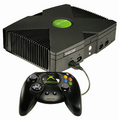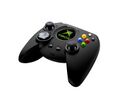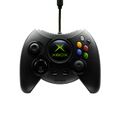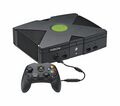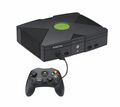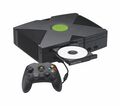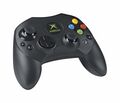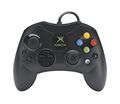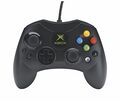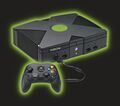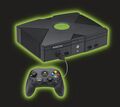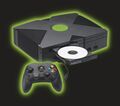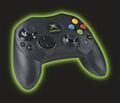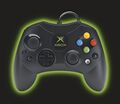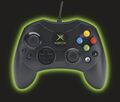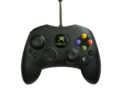Xbox
From Sega Retro

| |||||||||||||||||||||||||
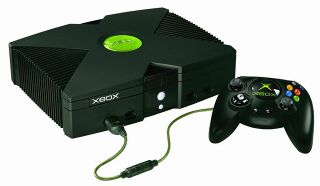
| |||||||||||||||||||||||||
| Xbox | |||||||||||||||||||||||||
|---|---|---|---|---|---|---|---|---|---|---|---|---|---|---|---|---|---|---|---|---|---|---|---|---|---|
| Manufacturer: Microsoft | |||||||||||||||||||||||||
|
The Xbox is a video game console developed by Microsoft, and was first released in late 2001. It was Microsoft's first independent venture into the console arena, and competed in the sixth generation of video game consoles, primarily against the PlayStation 2, Nintendo GameCube and to a lesser extent, the Sega Dreamcast. The Xbox was Microsoft's major console until 2005, when the Xbox's successor, the Xbox 360 launched.
Contents
Overview
Though the Xbox does not represent Microsoft's first foray into video games, it does represent their first attempt at a dedicated video game console. It was built by the team which had pioneered DirectX technology on Windows PCs (hence its working name, "DirectX Box"), and was the first major console since the Atari Jaguar to have been designed by a non-Japanese video game company. The Xbox is largely considered to be a relatively successful endeavour for Microsoft, though the company's business naivety when dealing with console gaming led to a number of issues which kept the Xbox behind the PlayStation 2 both in terms of content and sales. Notably, the Xbox performed abysmally in Japan and struggled throughout much of Europe, but performed much better in North America where it pushed the GameCube to third place.
From a technical perspective, the Xbox should be the most powerful console of its generation, but the GameCube is better suited to some tasks and some games designed for the PlayStation 2 (e.g. the Grand Theft Auto and Metal Gear Solid series) generally perform better on Sony's machine. For games designed as multi-platform from the outset, usually (but not always) the Xbox versions operate at higher resolutions and frame rates than the competition.
The Xbox was the first console to incorporate an 8-10GB hard drive (significantly larger than the memory cards required by the Japanese machines) which could in theory reduce loading times, but it is also plagued by poor design decisions - it is a much bigger and heavier console than its counterparts that is more susceptible to overheating.
The Xbox is also very poor at keeping time due to Microsoft's decision to use a "clock capacitor" rather than a traditional battery. This can affect games which use the clock to validate save files or trigger special events - if the system is not connected to mains power, the clock only stays active for about 8 hours, after which the user will need to reset it when the console is turned on. This capacitor is also a huge risk in older models - it is known to explode and cause damage to the console's internals, and can only be accessed by disassembling the unit.
The Xbox was disposed of relatively quickly after the launch of the far more successful Xbox 360 console. The 360 is backwards compatible with many Xbox games, but support is patchy and games may run better on the original unit. Similarly the Xbox One also supports a selection of original Xbox titles.
Sega support
Sega was one of the first major third-party publishers to back the Xbox, announcing that it would be publishing eleven video games for the platform during Tokyo Game Show 2001 Autumn[3]. The commitment from Sega was seen as something of a coup for Microsoft - with such a big Japanese publisher on board, it was hoped others from the region might follow suit, giving the console the much needed Japanese interest that had so far eluded the fledgling games machine.
Sega and Microsoft had worked closely with each other during the design of the Sega Dreamcast, with Sega benefiting from the inclusion of Windows CE, and Microsoft being able to experience the video game market at close range. Both were also eager to push the benefits of online gaming - a feeling perhaps not shared with Sony and Nintendo at the time. The Dreamcast is also thought to have influenced the design of the Xbox's controllers, with a similar button layout and two peripheral slots on the top.
At one point the Xbox was even planned to be able to run Dreamcast games, with Isao Okawa, then-president of Sega, having several meetings with Microsoft founder Bill Gates over the subject. The deal inevitably fell through due to online issues (Dreamcast online support conflicting with Microsoft's plans for the Xbox Live service), but the relationship between the two firms remained close, with Sega of America's Peter Moore migrating to Microsoft in the years that followed. The Sega Chihiro arcade board would also be derived from the Xbox, similar to how the NAOMI system stems from the Dreamcast.
Sega missed the US launch of the Xbox, but through Smilebit, was able to release two exclusive games to coincide with the Japanese and European launch windows in early 2002; Jet Set Radio Future and Gunvalkyrie. While highly rated, both sold poorly in Japan[4] - a recurring theme owed to Microsoft's inability to appeal to international audiences. This would be followed by the likes of Crazy Taxi 3: High Roller, Panzer Dragoon Orta, Sega GT 2002, The House of the Dead III, ToeJam & Earl III: Mission to Earth and World Series Baseball later in the year - all exclusive to the Xbox, but none able to entice the Japanese market.
While perhaps initially treating the Xbox as a "continuation" of the Dreamcast, the playing field was levelled in 2003, with Sega adopting a clearer multi-platform strategy for the Xbox, PlayStation 2 and GameCube. Roughly 50 games were released by Sega for the Xbox in total - more than the GameCube, but far less than the PlayStation 2.
A Panzer Dragoon Orta model of the Xbox console also released excuslively through Sega Direct on the 19th December 2002. Only 999 units were produced and were sold for ¥35,800[5].
Lists of Sega games for the Xbox
- 2 in 1 Combo Pack: Sonic Heroes/Super Monkey Ball Deluxe (2005)
- 2 in 1 Combo Pack: Sonic Mega Collection Plus/Super Monkey Ball Deluxe (2005)
- Crazy Taxi 3: High Roller (2002)
- ESPN College Hoops (2003)
- ESPN College Hoops 2K5 (2004)
- ESPN Major League Baseball (2004)
- ESPN NBA 2K5 (2004)
- ESPN NBA Basketball (2003)
- ESPN NFL 2K5 (2004)
- ESPN NFL Football (2003)
- ESPN NHL 2K5 (2004)
- ESPN NHL Hockey (2003)
- Gunvalkyrie (2002)
- Headhunter Redemption (2004)
- The House of the Dead III (2002)
- Iron Phoenix (2005)
- Jet Set Radio Future (2002)
- NBA 2K2 (2002)
- NBA 2K3 (2002)
- NCAA College Basketball 2K3 (2002)
- NCAA College Football 2K3 (2002)
- NFL 2K2 (2002)
- NFL 2K3 (2002)
- NHL 2K3 (2002)
- Otogi 2: Immortal Warriors (2004)
- Otogi: Myth of Demons (2003)
- OutRun 2 (2004)
- OutRun 2006: Coast 2 Coast (2006)
- Panzer Dragoon Orta (2002)
- Phantasy Star Online Episode I & II (2003)
- Puyo Pop Fever (2004)
- Rent A Hero No.1 (2003)
- Sega GT 2002 (2002)
- Sega GT 2002/Jet Set Radio Future (2002)
- Sega GT Online (2003)
- Sega Soccer Slam (2002)
- Shadow the Hedgehog (2005)
- Shenmue II (2002)
- Sonic Heroes (2003)
- Sonic Mega Collection Plus (2004)
- Sonic Riders (2006)
- Spartan: Total Warrior (2005)
- Spikeout: Battle Street (2005)
- Super Monkey Ball Deluxe (2005)
- Taito Legends (2005)
- ToeJam & Earl III: Mission to Earth (2002)
- World Series Baseball (2002)
- World Series Baseball 2K3 (2003)
- World Snooker Championship 2005 (2005)
- Worms 3D (2003)
- Worms Forts: Under Siege (2004)
By region
- List of Xbox games in Australia
- List of Xbox games in Brazil
- List of Xbox games in Canada
- List of Xbox games in France
- List of Xbox games in Germany
- List of Xbox games in Italy
- List of Xbox games in Japan
- List of Xbox games in Mexico
- List of Xbox games in Russia
- List of Xbox games in South Korea
- List of Xbox games in Spain
- List of Xbox games in Taiwan
- List of Xbox games in the United Kingdom
- List of Xbox games in the United States
Photo gallery
Xbox console, Panzer Dragoon Orta model
Promotional images
References
- ↑ 1.0 1.1 Xbox.com (News; 2101.htm/) (Wayback Machine: 2001-10-06 03:03)
- ↑ 2.0 2.1 http://xbox.jp:80/news/xbox/x_release20020222_01.html (Wayback Machine: 2002-03-05 20:45)
- ↑ http://www.sega.jp/release/nr010330_1e.html (Wayback Machine: 2002-11-17 06:18)
- ↑ Xbox Nation, "Summer 2002" (US; 2002-xx-xx), page 24
- ↑ http://sega.jp/corp/release/2002/1021_1/ (Wayback Machine: 2007-11-18 20:37)
| Non-Sega consoles |
|---|
| Nintendo |
| Nintendo Entertainment System (1983) | Game Boy (1989) | Super Nintendo Entertainment System (1990) | Nintendo 64 (1996) | Game Boy Color (1998) | Game Boy Advance (2001) | Nintendo GameCube (2001) | Nintendo DS (2004) | Wii (2006) | Nintendo 3DS (2011) | Wii U (2012) | Nintendo Switch (2017) |
| Sony |
| PlayStation (1994) | PlayStation 2 (2000) | PlayStation Portable (2004) | PlayStation 3 (2006) | PlayStation Vita (2011) | PlayStation 4 (2013) | PlayStation 5 (2020) |
| Microsoft |
| Xbox (2001) | Xbox 360 (2005) | Xbox One (2013) | Xbox Series X (2020) |
| Mobile |
| iOS | Android | Windows Phone |
| Other |
| Atari 2600 (1977) | ColecoVision (1982) | PC Engine (1987) | R-Zone (1995) | Game.com (1997) | WonderSwan (1998) | Neo Geo Pocket Color (1999) | N-Gage (2003) | LeapFrog Didj (2008) | Stadia (2019) |

